by David Greer
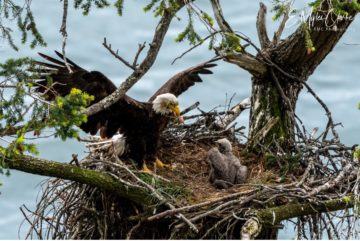
On the islands of the Salish Sea, spring is often interrupted by the final roars of winter’s lion. Firs and cedars that usually withstand storm winds from the west or south may break when a rare mass of Arctic air brings with it a mean gale from the north.
In a rural community, branches falling on wires can trigger power outages lasting hours or days. When that happens, the ancient woodstove takes over from the idled electric heat pump, while oil lamps brought out of the closet cast a warm and flickering light on the novel that has been waiting for just such an occasion. Sure, your iPhone may still have some juice left, but you’ve no idea whether the lights will be out for hours or days. What better excuse to bury yourself in a good book under a cozy woolen Hudson’s Bay blanket?
No power also means no water from the pump-driven dug well, but fortunately you had the presence of mind not to tear down the old outhouse from the cabin’s earliest days when indoor plumbing was a luxury enjoyed by few on these remote islands. As long as you remember to gently relocate any yellowjacket queens wintering under the toilet seat, there’s a certain pleasure to sitting in a privy overlooking the rainforest in the gloaming, the more so if you remembered to replace the empty toilet paper roll after the last power outage. On really stormy nights, you might even hear the waves crashing on the distant beach.
The romance of power failures tends to wear a little thin after the second or third outage of the season. There’s a certain masochistic appeal to lowering a bucket into the well to haul up water to wash three-day-old dishes, but it fades away rather quickly. When visions of hot summer days and fresh blackberry pie and warm showers start dancing in your head, you begin to heartily wish spring would quit its long flirtation and get a move-on.
Spring wastes no time in other parts of the continent. When I lived in Edmonton, Alberta, it was the end of May before the ice left the North Saskatchewan River, yet it seemed only a few weeks afterwards that we were picking wild strawberries while slapping at summer’s mosquitoes as big as military drones. In Edmonton it went like this: barely a month of spring, three months of summer, one month of fall, seven months of winter. Or so it seemed.
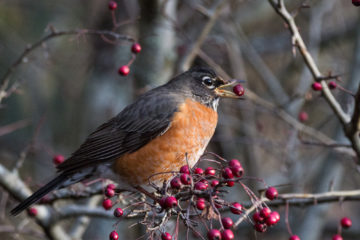
Spring is an altogether different creature on the Pacific coast. Robins and red-winged blackbirds are an unreliable first sign of spring, mainly because so many of them spend the whole winter here, where they’re joined by Alaskan expatriate robins who haven’t yet sworn off long-distance flying. A robin’s behavior is in large part dictated by the habits of the worm. When the worm goes deep to avoid occasional frost, the robin becomes a temporary fruitarian, making do with hawthorn and arbutus berries and the like. But when the frost is gone and the worms come back up, playing fields and parks are covered with legions of robins, heads simultaneously cocked, like so many avian line-dancers listening for the beat.
Birds Do It…
If any bird can lay claim to being the first true sign of spring on the Salish Sea, it would be either the bald eagle (Haliaeetus leucocephalus) or the Anna’s hummingbird (Calypte anna). Both start breeding as early as December, and not long afterwards are hard at work preparing their nurseries. The bald eagle’s massive framework of branches and sticks looks like an overturned Volkswagen Beetle high in a Douglas-fir at the edge of the ocean; the Anna’s nest is smaller than a teacup, lined with the softest lichen a parent can find.

You can tell when Anna’s hummingbirds are in the mood for love by a series of ear-piercing whistles splitting the air. That’s the sound produced by air rushing through the tail feathers of a male Anna’s diving from a great height at high speed (for trivia buffs, that’s up to 385 body lengths a second, the highest known length-specific velocity attained by any vertebrate). If the intended audience of the display deigns to notice the performance, the nest is on its way to being occupied. The mating of hummingbirds is a clamorous and rapid affair, just like any hummingbird activity. One year at the beginning of March while digging over the vegetable patch, I was startled by loud farting noises that sounded like balloons rapidly deflating and zipping through the air. I looked up to see a male and female Anna’s hummingbird seemingly locked together, caroming off bushes and tumbling into last year’s fallen leaves before bouncing back up and flying their separate ways. It was over quickly, though I may have missed the foreplay.
Early nesting is about the only habit bald eagles and Anna’s hummingbirds share in common, besides the fact that both species typically lay two eggs, the hummingbird’s about the size of a jellybean, the eagle’s bigger than an extra-large chicken egg. Bald eagles mate for life. With Anna’s hummingbirds, it’s a few furious seconds of unrestrained passion followed by “Enjoy the rest of your day”. Male eagles fulfil the role of the dutiful parent to a tee, delivering tasty chunks of carrion to demanding chicks throughout their roughly three-month occupation of the nest. The male Anna’s hummingbird considers his duty done the instant of his tiny ejaculation. A moment later, he’s likely to be off flashing his iridescent gorge and making his marmot whistle for the benefit of whatever other Anna’s catches his eye. By contrast, some female Anna’s hummingbirds are such committed parents they start building a second nest for a later brood even before the fledglings in the first one have flown.
If it came to a showdown between a bald eagle and an Anna’s hummingbird, I might think twice about putting my money on the eagle. What the Anna’s lacks in size, it makes up for many times over in attitude. And that rapier beak could poke your eye out, if you’re not careful, or perhaps if you’re an overconfident eagle. I recently talked to a man who told me he had been speared in the forehead by an Anna’s hummingbird, though he generously gave the bird the benefit of the doubt and concluded the damage had been unintentional.
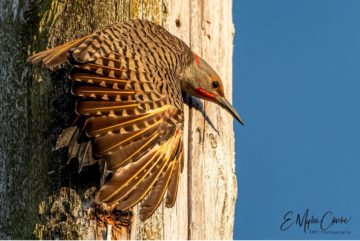
Another local bird with a noisy courting habit in spring is the northern flicker (Colaptes auratus). If you’re woken at the crack of dawn some spring morning by what sounds like an appointment between your metal gutters and a jackhammer, it’s most likely a flicker convinced that the way to impress a potential mate is to make as loud a racket as possible at as early an hour as possible. The sound of beak on aluminum is so much more rewarding than the sound of beak on bark to a flicker on the make. When they’re not hammering metal objects such as gutters and streetlights, flickers content themselves with probing dead or diseased trees for grubs.
A woodpecker with a very different dietary preference is the red-breasted sapsucker (Sphyrapicus ruber), which drills neat rows of holes in the bark of a tree, revisiting it later on several occasions to sip the sap that slowly fills the holes. Birches are among the trees most favoured by sapsuckers, thanks to the thinness of their bark and, presumably, the quality of their sap. Whatever the reason, I most frequently see sapsuckers in the early spring and usually on birch trees. Bigleaf maples reportedly produce the best sap among Pacific Northwest trees (according to the syrup-tapping clan), but it would take a determined sapsucker to breach the maple’s thick armor.
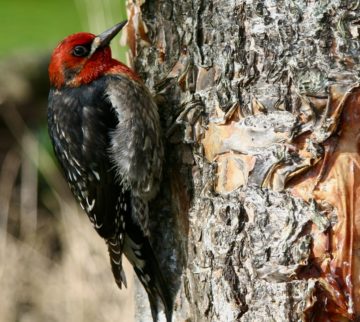
Until fairly recent years, another reliable indicator of spring on these islands was the drumming of blue grouse (Dendragapus obscurus) echoing through the woods, a sound long since silenced, most likely thanks to feral cats with a taste for the eggs of ground-nesting birds. Pheasants—non-native but a bright flash of color in the woods—are also gone, most likely for the same human-caused reason.
No discussion of birds as signs of spring would be complete without a mention of the spring migration. One day last March there entered my consciousness a sound so faint I could barely make it out, yet so familiar I stopped whatever I was doing to gaze up to the skies. What I was doing, in this case, happened to be playing golf, and it was my turn to hit, but the sight of swans or geese half a mile high or more on a 4,000-mile journey is a sight that commands undivided attention for the minute or two it takes for them to disappear from sight. Fortunately, my playing partners were sufficiently familiar with my birding interests to grant me a little leeway, which probably meant patiently waiting for me at the next tee after I had picked up my ball on the fairway without finishing the hole. Perhaps I even recorded a penalty, but the reward had been so many times greater that the penalty was easily forgotten. Given that birdies and eagles seem to be held in such high esteem in golf, it puzzles me that the rules make no allowance for distraction by the real thing.
But back to the birdies in question. So high up I could barely make out individual shapes, two ragged white vees edged arrow-straight, true north. Their faint cries were not the raucous honks of resident Canada goose shit-factories but more like the high-pitched bleats of puppies. Though a Google search found a site describing the calls of snow geese as being like the cacophony produced by a pack of baying hounds, I took these to be tundra swans ((Cygnus columbianus, formerly known as whistling swans), as I couldn’t spot a trace of black on the wings. If so, they were on their way to the Bering Sea from southern California, and their journey had barely started.
It’s hard to put into words the emotional tug caused by the sight of large birds migrating such long distances. Smaller birds such as purple martins fly all the way from southeastern Brazil to breed on Vancouver Island, and while we welcome their visit, they get little acclaim for their feat. There’s something especially inspiring about the visual impact of a flock of swans flying with such singular focus as a team in which every member relies on wind resistance to benefit from and support each of its neighbors, and in which the role of leader circulates among every member with nary a ruffled feather or display of dominance. One for all, all for one, and an unwavering dedication to the best of all possible worlds for every bird in the flock. The great advantage of being a bird brain is being able to take action for the common good without agonizing over the consequences for your own well-being. If only human brains were capable of such simple problem-solving skills. When in disgrace with fortune and men’s eyes, just watch a flock of migrating tundra swans and you’re bound to feel a whole lot better.
Bees Do It…
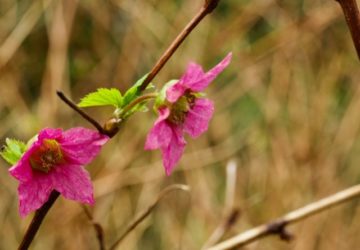
Among the pollinators making routine appearances in March are the yellow-rumped (though sometimes red-rumped) bumblebees lurching through the clearing in first gear, loud and low, careening into salmonberry branches like bears sleepily emerging from winter hibernation. Bumblebees are often the first in the bee family to make an appearance in spring, and the stumbling bumblebee I saw was most likely a queen reconnoitering potential nest sites. Bumblebees are a bit like Moose in the old Archie comics—massive, awkward, lovable, well-meaning, but still conveying ththe main difference being that bumblebees convey the sense (at least to me) of having a somewhat higher level of consciousness than other insects.
Thus it came as no surprise when I learned recently that a researcher looking for novel topic found that bumblebees could be taught to open a puzzle box with a sugar reward inside and then pass that acquired knowledge on to others in the colony, who in turn passed it on to others—proof, evidently, of capacity for culture. Scientists and bees make a great team. Scientists are forever coming up with new findings about what makes bees tick, and bees remain such mysterious creatures that they are forever providing novel topics for research scientists in need of an epiphany—the most recent example being the discovery of how honeybees learn the waggle dance that indicates the direction of food, water or nest sites.
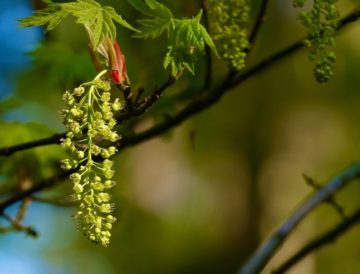
I have on occasion given in to the temptation to gently stroke a meandering bumblebee. I would be less inclined to do the same for a wasp, but when I hear a faint telltale scraping sound from the direction of the garden a little later in March, I head out to the cedar fencepost where a worker wasp (not the queen relocated from under the outhouse toilet seat) is painstakingly backing down the post as a grey ball of paper grows ever larger beneath its mandibles.
The go-ahead for pollinators to show up in spring is the appearance of something to pollinate. The first flower to bloom in the island forest is the salmonberry, a blaze of pink against the drab winter browns, followed soon afterwards by the blooms of the wild flowering currant, soon to be dwarfed by the giant and prolific lantern-like flowers of the bigleaf maple, which will soon fill the air of this glade with clouds of pollen of the palest green.
But the first signs of spring in the floral world in the islands of the Salish Sea are not the flowers but the reddening stems of salal and swamp willow when the calendar insists it’s still the depth of winter here. Then begins the green renewal, led by the stinging nettles bursting through the forest duff, usually in very early February. Stinging nettles, though not likely to win a popularity contest among children who brush bare arms against their hairy leaves, are packed with useful properties. Indigenous peoples carefully wove their fibrous stems into strong rope for fishing nets.[1] The leaves of young stinging nettles are as nutritious as spinach (boiling them neutralizes the sting). The bibles of the back-to-the-landers of the 1960s included Euell Gibbons’ books on the uses of wild plants. In Stalking the Healthful Herbs, he included recipes for creamed nettle, nettle pudding, and nettle beer. Gibbons neglected to mention that nettles steeped in water in a garbage bin provide a powerful “tea” for fertilizing crops. I tried this with great success one summer until a gang of marauding deer broke in one night and laid waste to everything remotely edible in the vegetable patch. Sadly, there were no cougars present.
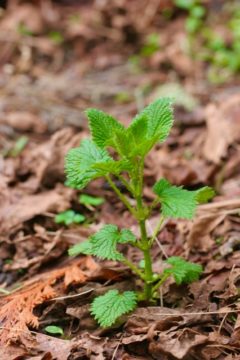
The problem with identifying the time when each new sign of spring takes place is that it varies from year to year, has always done so, and will do so in an even more exaggerated manner as the impacts of climate change become more apparent. During the twenty-odd years that I have been keeping a diary of natural history observations, the dates of the first appearance of stinging nettle plants above the forest duff have varied by up to a month. The same holds true for the opening night of the annual Pacific chorus frog extravaganza.
Ask the average islander to name the first real sign of spring and there’s a good chance he might say it’s the loud chorus of Pacific chorus frogs that erupts in (typically) mid-February so suddenly and unanimously one is tempted to imagine an amphibian conductor with baton at the ready to signal the multitudes to begin. But by that time, spring on the Salish Sea is already two months gone, in the eagle and hummingbird calendar, with three long months more to go until the warblers and Swainson’s thrushes arrive to proclaim the arrival of summer.
[1] Nancy J. Turner and Richard J. Hebda, Saanich Ethnobotany. Victoria, B.C.: Royal British Columbia Museum, 2019. Pp. 146-47.
§ §
Thanks to Myles Clarke (Instagram @emylesclarke) for permission to publish his photos of a bald eagle and northern flicker, and to Bruce Tuck for permission to publish his photos of a robin and an Anna’s hummingbird. See www.birdsinmyview.com for more of Bruce’s work. Thanks also to Brian Harvey for insightful edits.
